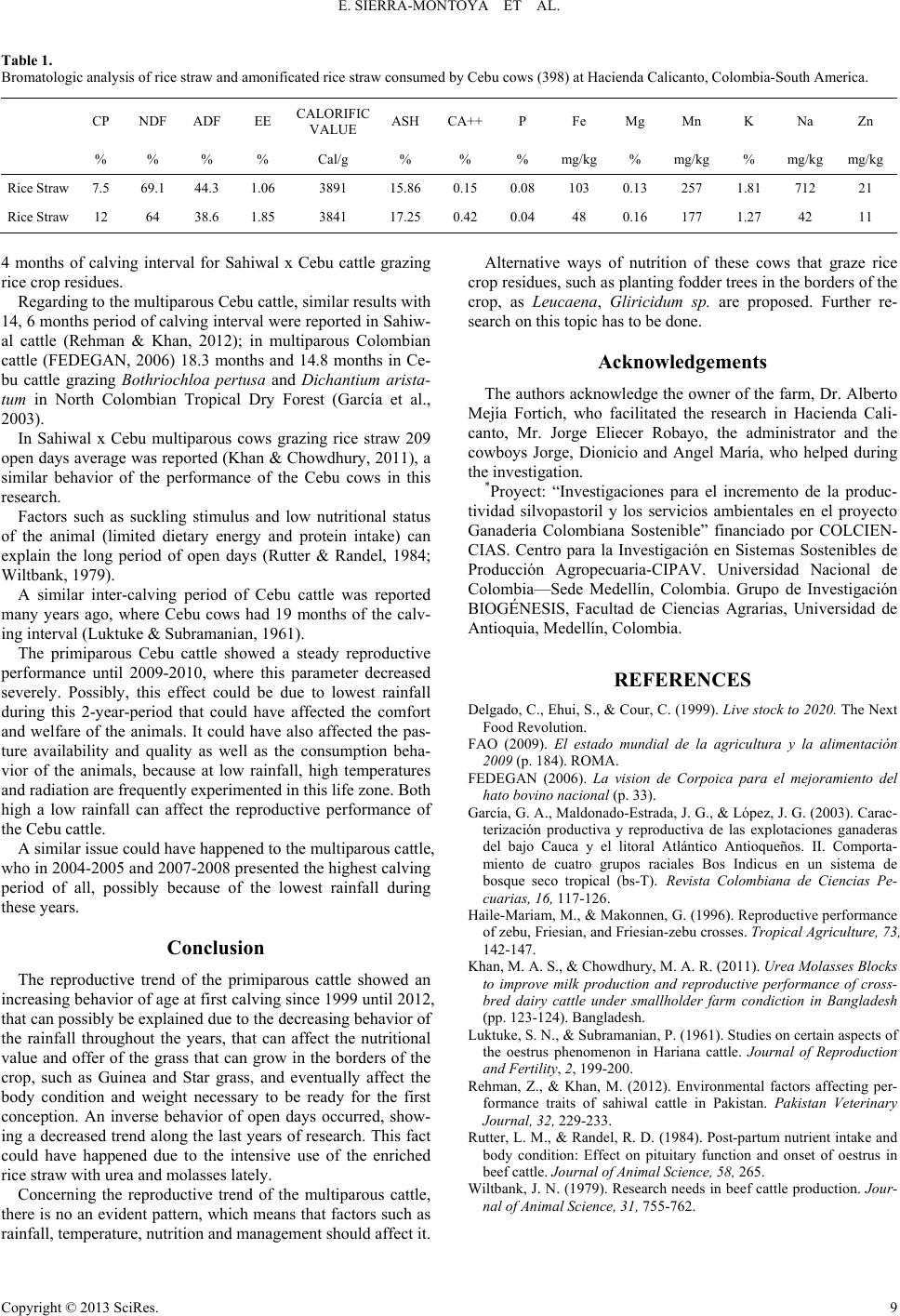
E. SIERRA-MONTOYA ET AL.
Copyright © 2013 SciRes.
Table 1.
Bromatologic analysis of rice straw and amonificated rice straw consumed by Cebu cows (398) at Hacienda Calicanto, Colombia-South America.
CP NDF ADF EE CALORIFIC
VALUE ASH CA++ P Fe Mg Mn K Na Zn
% % % % Cal/g % % % mg/kg % mg/kg % mg/kg mg/kg
Rice Straw 7.5 69.1 44.3 1.06 3891 15.86 0.15 0.08 103 0.13 257 1.81 712 21
Rice Straw 12 64 38.6 1.85 3841 17.25 0.42 0.04 48 0.16 177 1.27 42 11
4 months of calving interval for Sahiwal x Cebu cattle grazing
rice crop residues.
Regarding to the multiparous Cebu cattle, similar results with
14, 6 months period of calving interval were reported in Sahiw-
al cattle (Rehman & Khan, 2012); in multiparous Colombian
cattle (FEDEGAN, 2006) 18.3 months and 14.8 months in Ce-
bu cattle grazing Bothriochloa pertusa and Dichantium arista-
tum in North Colombian Tropical Dry Forest (García et al.,
2003).
In Sahiwal x Cebu multiparous cows grazing rice straw 209
open days average was reported (Khan & Chowdhury, 2011), a
similar behavior of the performance of the Cebu cows in this
research.
Factors such as suckling stimulus and low nutritional status
of the animal (limited dietary energy and protein intake) can
explain the long period of open days (Rutter & Randel, 1984;
Wiltbank, 1979).
A similar inter-calving period of Cebu cattle was reported
many years ago, where Cebu cows had 19 months of the calv-
ing interval (Luktuke & Subramanian, 1961).
The primiparous Cebu cattle showed a steady reproductive
performance until 2009-2010, where this parameter decreased
severely. Possibly, this effect could be due to lowest rainfall
during this 2-year -period that could have affected the comfort
and welfare of the animals. It could have also affected the pas-
ture availability and quality as well as the consumption beha-
vior of the animals, because at low rainfall, high temperatures
and radiation are frequently experimented in this life zone. Both
high a low rainfall can affect the reproductive performance of
the Cebu cattle.
A similar issue cou l d ha ve happened to the multiparous cattle,
who in 2004-2005 and 2007-2008 presented the highest calving
period of all, possibly because of the lowest rainfall during
these years.
Conclusion
The reproductive trend of the primiparous cattle showed an
increasing behavior of age at first calving since 1999 until 2012,
that can possibly be explained due to the decreasing behavior of
the rainfall throughout the years, that can affect the nutritional
value and offer of the grass that can grow in the borders of the
crop, such as Guinea and Star grass, and eventually affect the
body condition and weight necessary to be ready for the first
conception. An inverse behavior of open days occurred, show-
ing a decreased trend along the last years of research. This fact
could have happened due to the intensive use of the enriched
rice straw with urea and molasses lately.
Concerning the reproductive trend of the multiparous cattle,
there is no an evident pattern, which means that factors such as
rainfall, temperature, nutrition and management should affect it.
Alternative ways of nutrition of these cows that graze rice
crop residues, such as planting fodder trees in the borders of the
crop, as Leucaena, Gliricidum sp. are proposed. Further re-
search on this topic has to be done.
Acknowledgements
The authors acknowledge the owner of the farm, Dr. Alberto
Mejía Fortich, who facilitated the research in Hacienda Cali-
canto, Mr. Jorge Eliecer Robayo, the administrator and the
cowboys Jorge, Dionicio and Angel María, who helped during
the investigation.
*Proyect: “Investigaciones para el incremento de la produc-
tividad silvopastoril y los servicios ambientales en el proyecto
Ganadería Colombiana Sostenible” financiado por COLCIEN-
CIAS. Centro para la Investigación en Sistemas Sostenibles de
Producción Agropecuaria-CIPAV. Universidad Nacional de
Colombia—Sede Medellín, Colombia. Grupo de Investigación
BIOGÉNESIS, Facultad de Ciencias Agrarias, Universidad de
Antioquia, Medellín, Colombia.
REFERENCES
Delgado, C., Eh ui, S., & Co ur, C. (199 9). Live stock to 2020. The Next
Food Revolution.
FAO (2009). El estado mundial de la agricultura y la alimentación
2009 (p. 184). ROMA.
FEDEGAN (2006). La vision de Corpoica para el mejoramiento del
hato bovino nacional (p. 33).
García, G. A., Maldonado-Est rada, J. G., & López, J. G . (2003). C arac-
terización productiva y reproductiva de las explotaciones ganaderas
del bajo Cauca y el litoral Atlántico Antioqueños. II. Comporta-
miento de cuatro grupos raciales Bos Indicus en un sistema de
bosque seco tropical (bs-T). Revista Colombiana de Ciencias Pe-
cuarias, 16, 117-126.
Haile-Mariam, M., & Makonnen, G. (1996). Reproductive performance
of zebu, Friesian, and Friesian-zebu crosses. Tro pical Agricu lture, 73,
142-147.
Khan, M. A. S., & C how dh ury, M. A. R. (20 11 ). Urea Mo lasses Blo cks
to improve milk production and reproductive performance of cross-
bred dairy cattle under smallholder farm condiction in Bangladesh
(pp. 123-124). Ba ngladesh.
Luktuke, S. N., & Subramanian, P. (1961). Studies o n certain asp ects o f
the oestrus phenomenon in Hariana cattle. Journal of Reproduction
and Fertility, 2, 199-200.
Rehman, Z., & Khan, M. (2012). Environmental factors affecting per-
formance traits of sahiwal cattle in Pakistan. Pakistan Veterinary
Journal, 32, 229-233.
Rutter, L. M ., & Randel, R. D. (1 984). Post-partu m nutrient intake and
body condition: Effect on pituitary function and onset of oestrus in
beef cattle. Journal of Animal Science, 58, 265.
Wiltbank, J. N. (1979 ). Research needs in beef cattle production . Jour-
nal of Animal Science, 31, 755-762.